Intel at Computex 2021: New Tiger Lake Processors, Beast Canyon NUC, 5G Chips
Intel kicked off Computex 2021 by adding two new flagship 11th-Gen Tiger Lake U-series chips to its stable, including a new Core i7 model that's the first laptop chip for the thin-and-light segment that boasts a 5.0 GHz boost speed. As you would expect, Intel also provided plenty of benchmarks to show off its latest silicon.
Intel also teased its upcoming Beast Canyon NUCs that are the first to accept full-size graphics cards, making them more akin to a small form factor PC than a NUC. These new machines will come with Tiger Lake processors. Additionally, the company shared a few details around its 5G Solution 5000, its new 5G silicon for Always Connected PCs that it developed in partnership with MediaTek and Fibocom. Let's jump right in.
Intel 11th-Gen Tiger Lake U-Series Core i7-1195G7 and i5-1155G7
Intel's two new U-series Tiger Lake chips, the Core i7-1195G7 and Core i5-1155G7, slot in as the new flagships for the Core i7 and Core i5 families. These two processors are UP3 models, meaning they operate in the 12-28W TDP range. These two new chips come with all the standard features of the Tiger Lake family, like the 10nm SuperFin process, Willow Cove cores, the Iris Xe graphics engine, and support for LPDDR4x-4266, PCIe 4.0, Thunderbolt 4 and Wi-Fi 6/6E.
Intel expects the full breadth of its Tiger Lake portfolio to span 250 designs by the holidays from the usual suspects, like Lenovo MSI, Acer and ASUS, with 60 of those designs with the new 1195G7 and 1155G7 chips.
| PROCESSOR | CORES/THREADS | GRAPHICS (EUs) | OPERATING RANGE (W) | BASE CLOCK (GHZ) | SINGLE CORE TURBO FREQ (GHZ) | MAXIMUM ALL CORE FREQ (GHZ) | Cache (MB) | GRAPHICS MAX FREQ (GHZ) | MEMORY |
|---|---|---|---|---|---|---|---|---|---|
| Core i7-1195G7 | 4C / 8T | 96 | 12 -28W | 2.9 | 5.0 | 4.6 | 12 | 1.40 | DDR4-3200, LPDDR4x-4266 |
| Core i7-1185G7 | 4C / 8T | 96 | 12 - 28W | 3.0 | 4.8 | 4.3 | 12 | 1.35 | DDR4-3200, LPDDR4x-4266 |
| Core i7-1165G7 | 4C / 8T | 96 | 12 - 28W | 2.8 | 4.7 | 4.1 | 12 | 1.30 | DDR4-3200, LPDDR4x-4266 |
| Core i5-1155G7 | 4C / 8T | 80 | 12 - 28W | 2.5 | 4.5 | 4.3 | 8 | 1.35 | DDR4-3200, LPDDR4x-4266 |
| Core i5-1145G7 | 4C / 8T | 80 | 12 - 28W | 2.6 | 4.4 | 4.0 | 8 | 1.30 | DDR4-3200, LPDDR4x-4266 |
| Core i5-1135G7 | 4C / 8T | 80 | 12 - 28W | 2.4 | 4.2 | 3.8 | 8 | 1.30 | DDR4-3200, LPDDR4x-4266 |
| Core i3-1125G4* | 4C / 8T | 48 | 12 - 28W | 2.0 | 3.7 | 3.3 | 8 | 1.25 | DDR4-3200, LPDDR4x-3733 |
The four-core eight-thread Core i7-1195G7 brings the Tiger Lake UP3 chips up to a 5.0 GHz single-core boost, which Intel says is a first for the thin-and-light segment. Intel has also increased the maximum all-core boost rate up to 4.6 GHz, a 300 MHz improvement.
Intel points to additional tuning for the 10nm SuperFin process and tweaked platform design as driving the higher boost clock rates. Notably, the 1195G7's base frequency declines by 100 MHz to 2.9 GHz, likely to keep the chip within the 12 to 28W threshold. As with the other G7 models, the chip comes with the Iris Xe graphics engine with 96 EUs, but those units operate at 1.4 GHz, a slight boost over the 1165G7's 1.35 GHz.
The 1195G7's 5.0 GHz boost clock rate also comes courtesy of Intel's Turbo Boost Max Technology 3.0. This boosting tech works in tandem with the operating system scheduler to target the fastest core on the chip ('favored core') with single-threaded workloads, thus allowing most single-threaded work to operate 200 MHz faster than we see with the 1185G7. Notably, the new 1195G7 is the only Tiger Lake UP3 model to support this technology.
Surprisingly, Intel says the 1195G7 will ship in higher volumes than the lower-spec'd Core i7-1185G7. That runs counter to our normal expectations that faster processors fall higher in the binning distribution — faster chips are typically harder to produce and thus ship in lower volumes. The 1195G7's obviously more forgiving binning could be the result of a combination of the lower base frequency, which loosens binning requirements, and the addition of Turbo Boost Max 3.0, which only requires a single physical core to hit the rated boost speed. With Turbo Boost 2.0, Intel requires all cores to hit the boost clock speed, which makes binning more challenging.

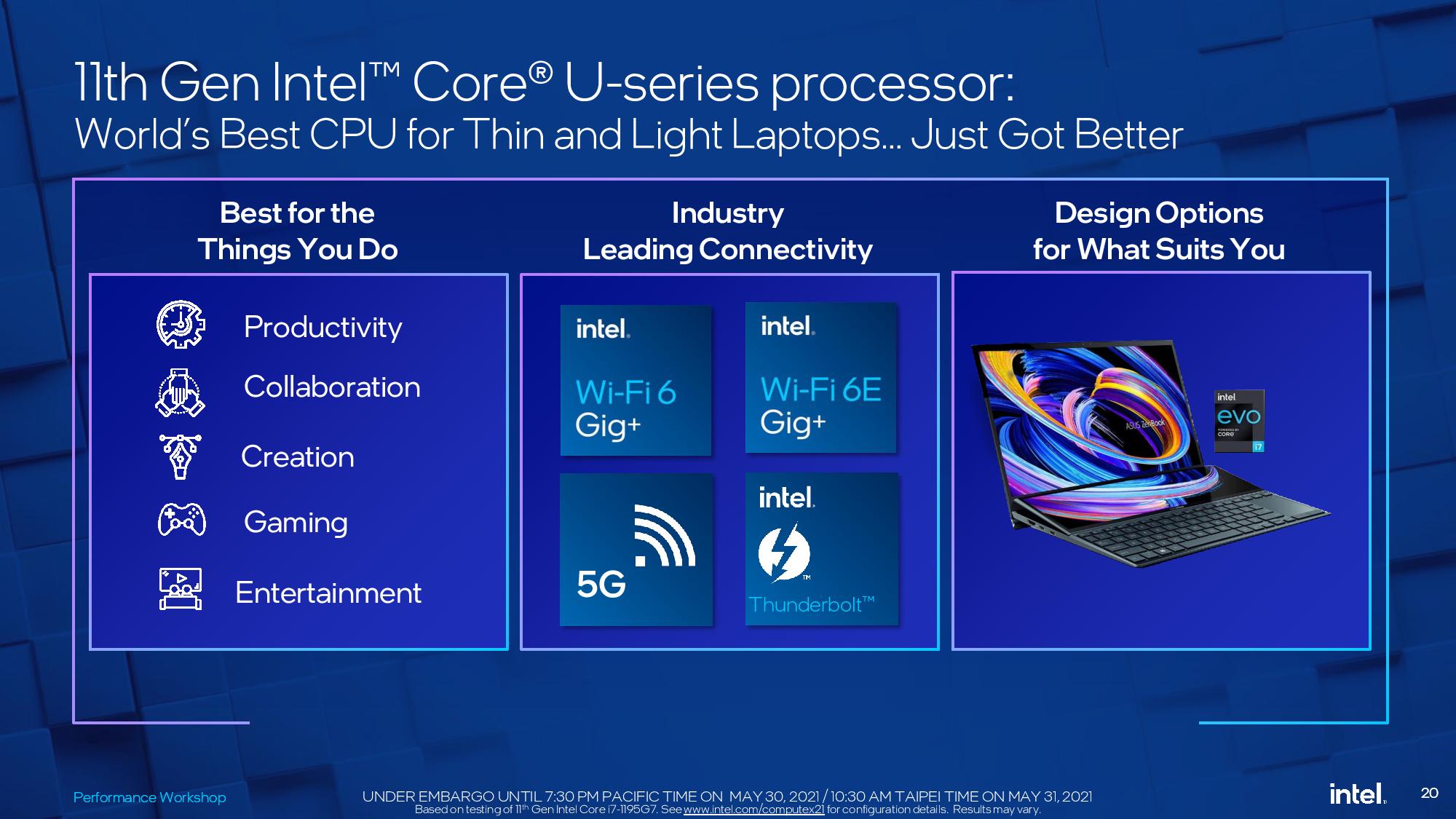
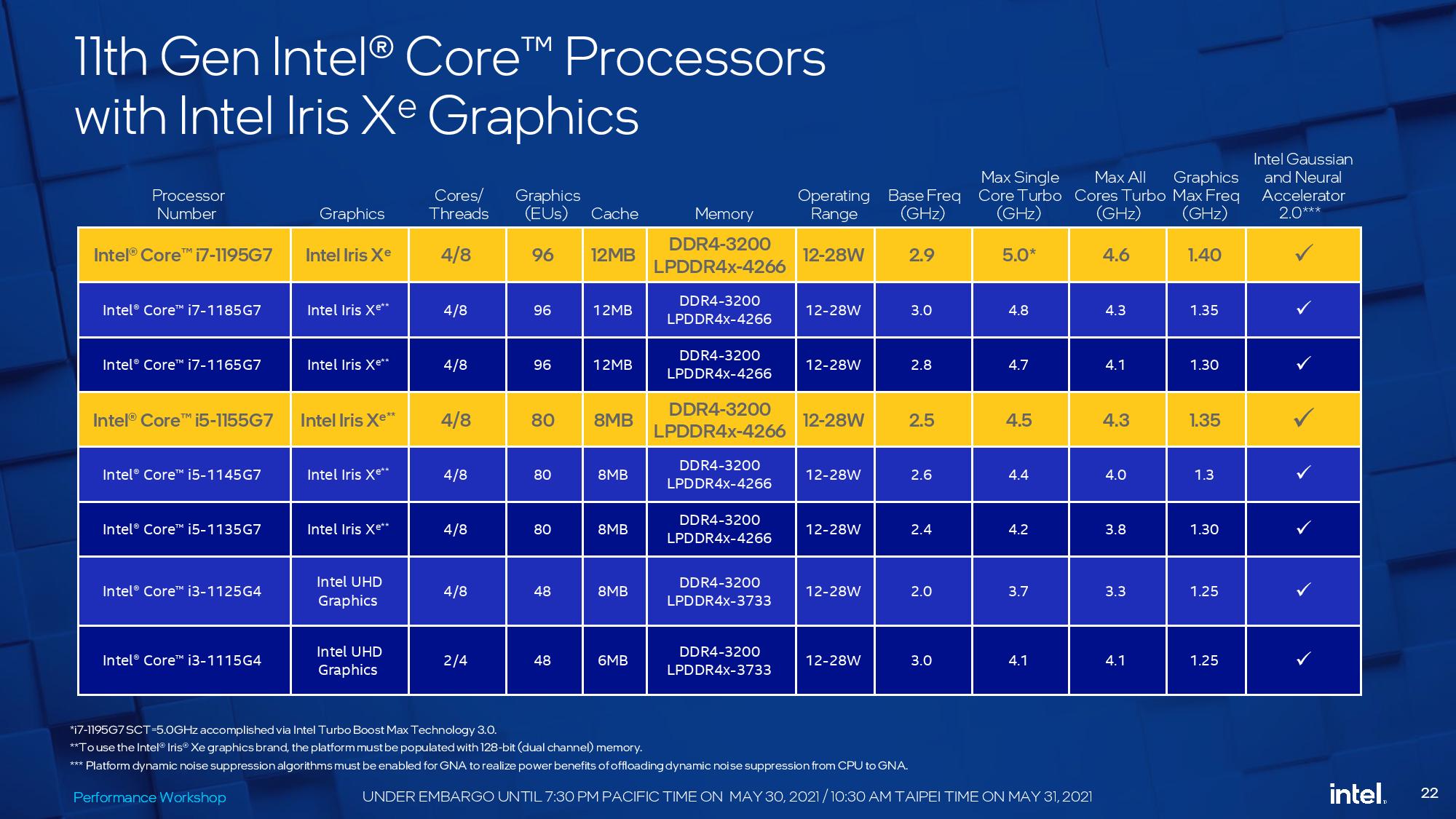
The four-core eight-thread Core i5-1155G7 sees more modest improvements over its predecessor, with boost clocks jumping an additional 100 MHz to 4.5 GHz, and all-core clock rates improving by 300 MHz to 4.3 GHz. We also see the same 100 MHz decline in base clocks that we see with the 1195G7. This chip comes with the Iris Xe graphics engine with 80 EUs that operate at 1.35 GHz.
Intel's Tiger Lake Core i7-1195G7 Gaming Benchmarks
Intel shared its own gaming benchmarks for the Core i7-1195G7, but as with all vendor-provided benchmarks, you should view them with skepticism. Intel didn't share benchmarks for the new Core i5 model.
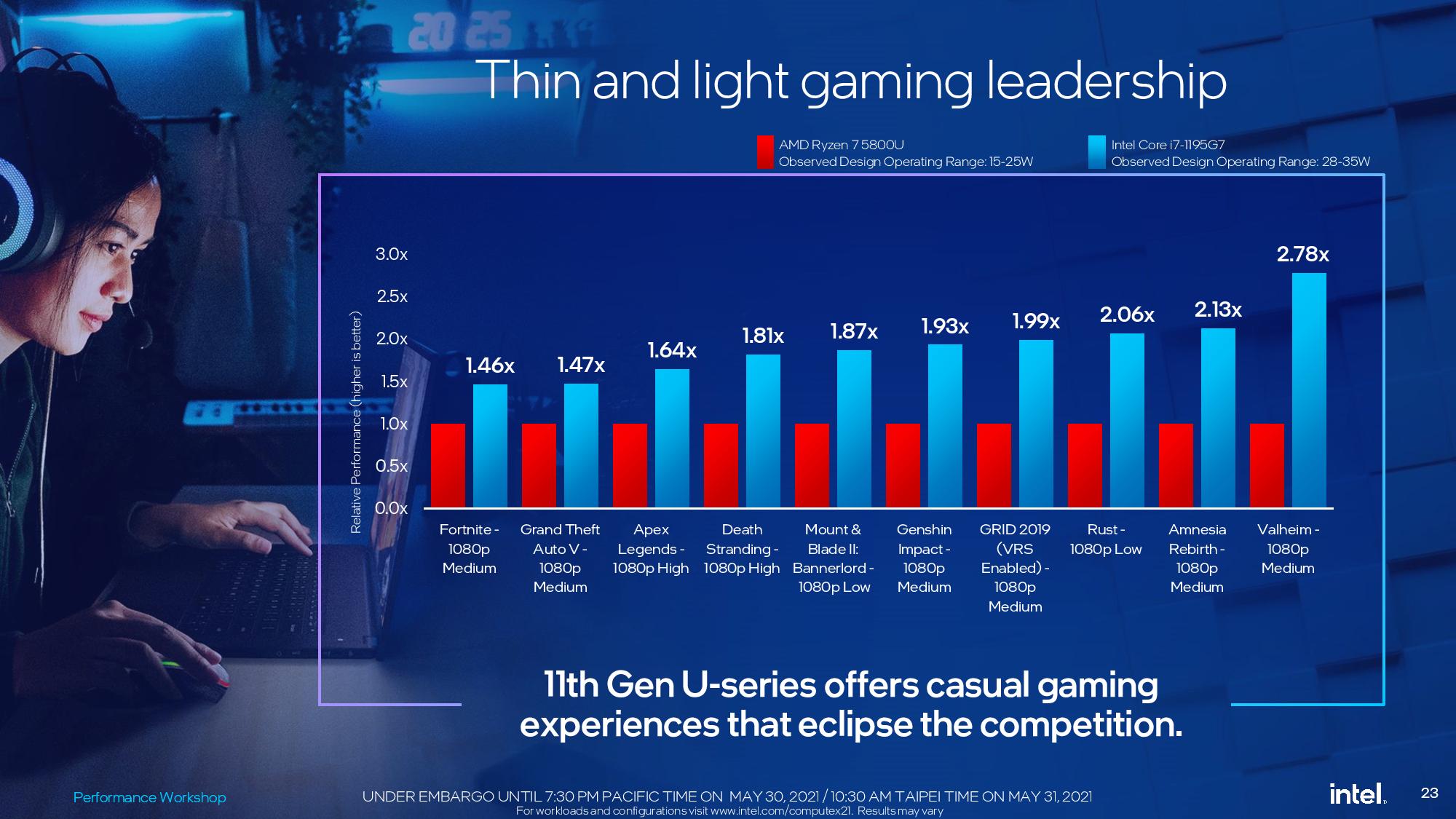
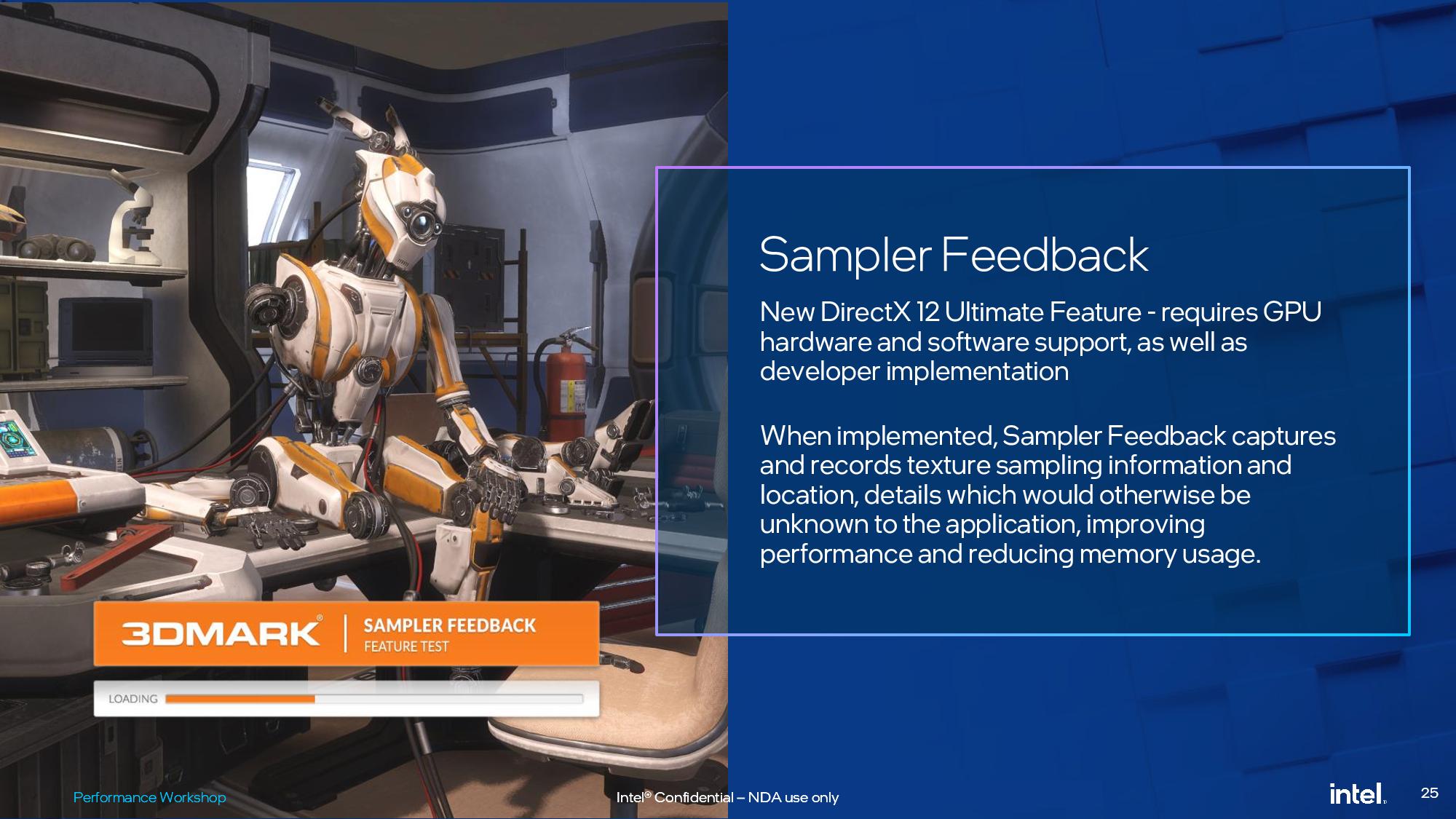
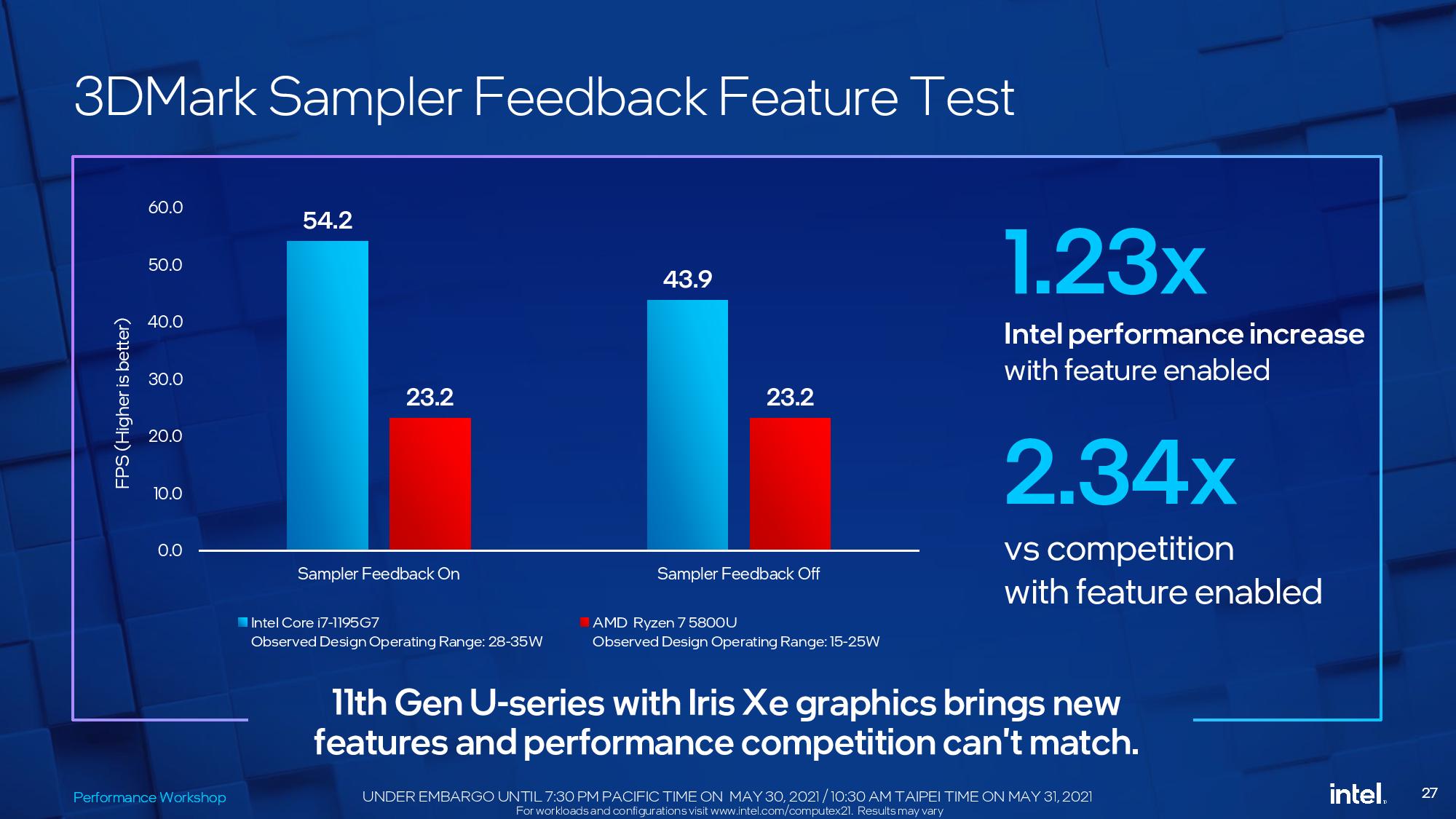
Intel put its Core i7-1195G7 up against the AMD Ryzen 7 5800U, but the chart lists an important caveat here — Intel's system operates between 28 and 35W during these benchmarks, while AMD's system runs at 15 to 25W. That's because Intel compares the 15W Cezzane chips to its own 28W processors, which is far from an even comparison. Intel conducted these tests on the integrated graphics for both chips, so we're looking at Iris Xe with 96 EUs versus AMD's Vega architecture with eight CUs.
Naturally, Intel's higher power consumption leads to higher performance, thus giving the company the lead across a broad spate of triple-A 1080p games. However, this extra performance comes at the cost of higher power consumption and thus more heat generation. Intel also tested using its Reference Validation Platform with unknown cooling capabilities (we assume they are virtually unlimited) while testing the Ryzen 7 5800U in the HP Probook 455.
Intel also provided benchmarks with DirectX 12 Ultimate's new Sampler Feedback feature. This new DX12 feature reduces memory usage while boosting performance, but it requires GPU hardware-based support in tandem with specific game engine optimizations. That means this new feature will not be widely available in leading triple-A titles for quite some time.
Intel was keen to point out that its Xe graphics architecture supports the feature, whereas AMD's Vega graphics engine does not. ULMark has a new 3DMark Sampler Feedback benchmark under development, and Intel used the test release candidate to show that Iris Xe graphics offers up to 2.34X the performance of AMD's Vega graphics with the feature enabled.
Intel's Tiger Lake Core i7-1195G7 Application Benchmarks
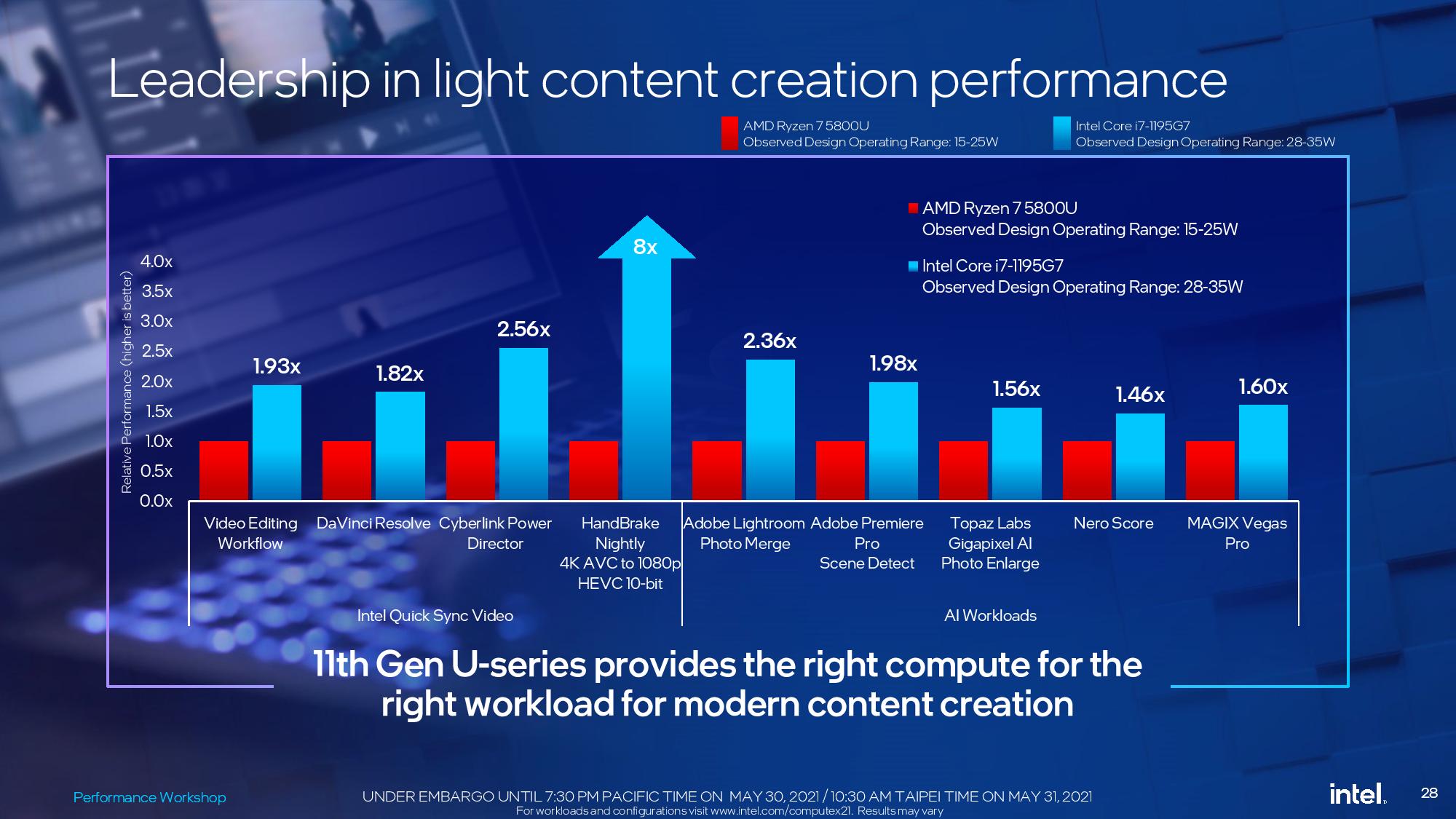
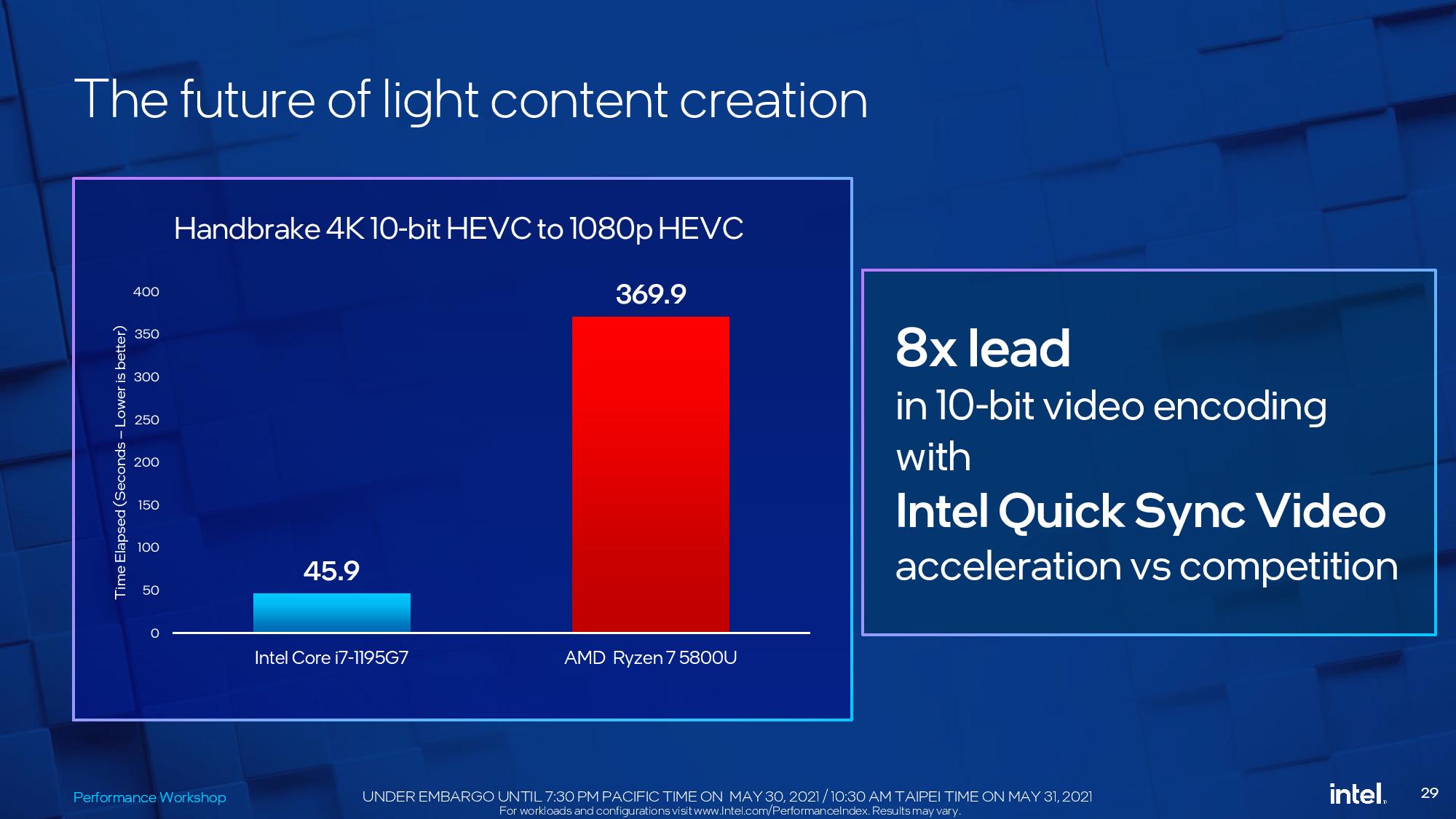
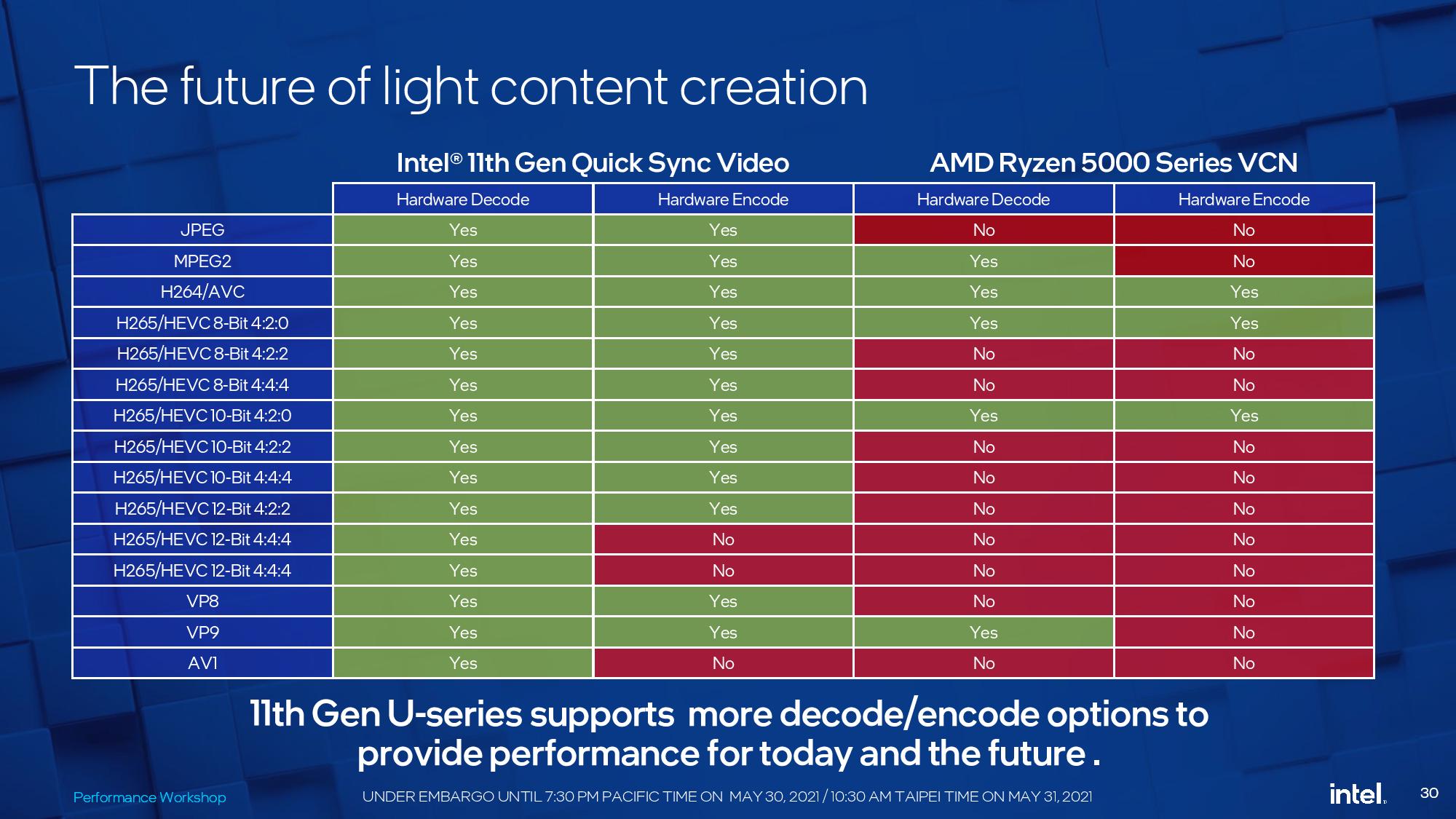
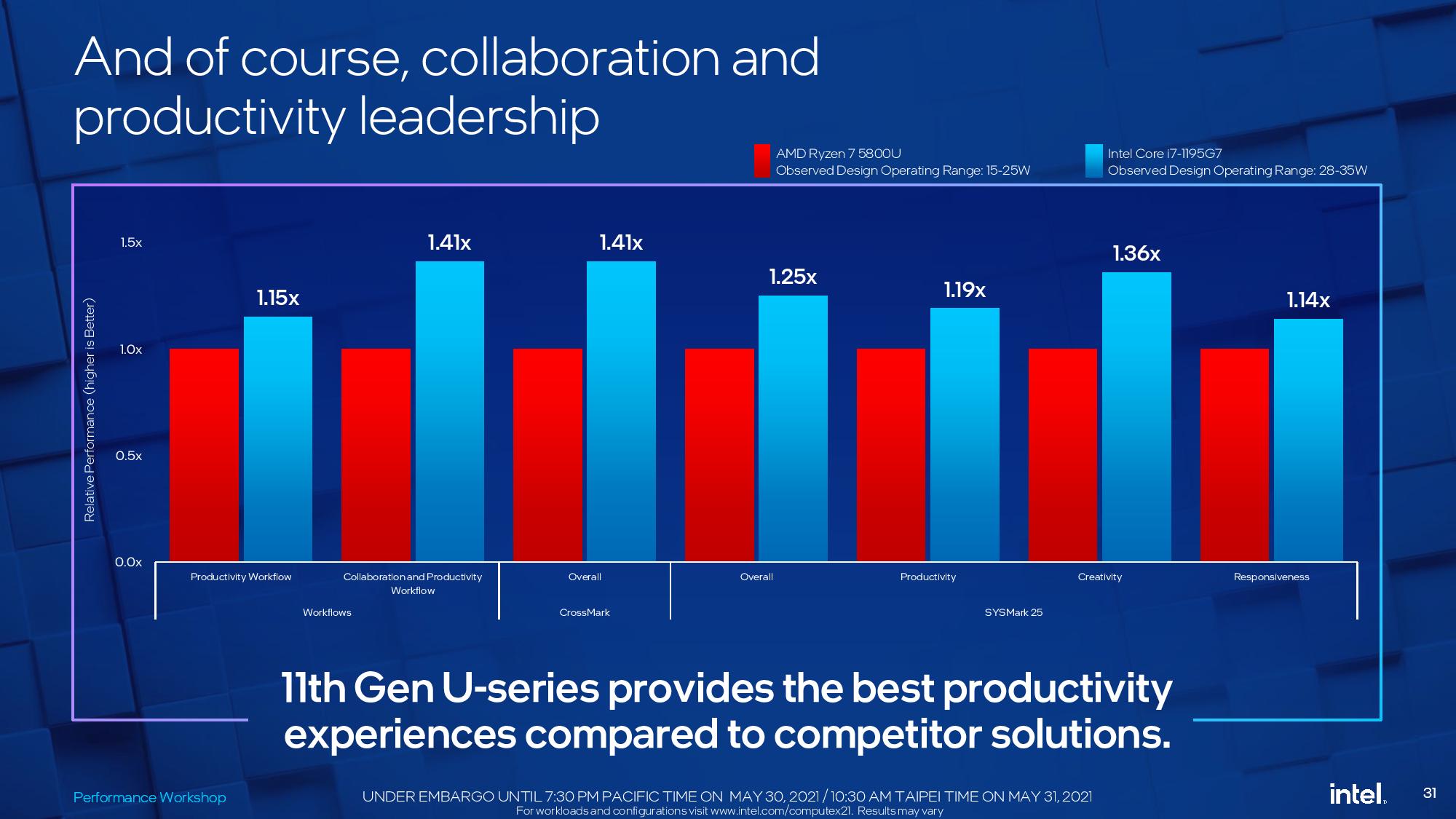
Here we can see Intel's benchmarks for applications, too, but the same rules apply — we'll need to see these benchmarks in our own test suite before we're ready to claim any victors. Again, you'll notice that Intel's system operates at a much higher 28 to 35W power range on a validation platform while AMD's system sips 15 to 25W in the HP Probook 455 G8.
As we've noticed lately, Intel now restricts its application benchmarks to features that it alone supports at the hardware level. That includes AVX-512 based benchmarks that leverage the company's DL Boost suite that has extremely limited software support.
Intel's benchmarks paint convincing wins across the board. However, be aware that the AI-accelerated workloads on the right side of the chart aren't indicative of what you'll see with the majority of productivity software. At least not yet. For now, unless you use these specific pieces of software very frequently in these specific tasks, these benchmarks aren't very representative of the overall performance deltas you can expect in most software.
In contrast, the Intel QSV benchmarks do have some value. Intel's Quick Sync Video is broadly supported, and the Iris Xe graphics engine supports hardware-accelerated 10-bit video encoding. That's a feature that Intel rightly points out also isn't supported with MX-series GPUs, either.
Get Tom's Hardware's best news and in-depth reviews, straight to your inbox.
Intel's support for hardware-accelerated 10-bit encoding does yield impressive results, at least in its benchmarks, showing a drastic ~8X reduction in a Handbrake 4K 10-bit HEVC to 1080P HEVC transcode. Again, bear in mind that this is with the Intel chip running at a much higher power level. Intel also shared a chart highlighting its broad support for various encoding/decoding options that AMD doesn't support.
Intel Beast Canyon NUC

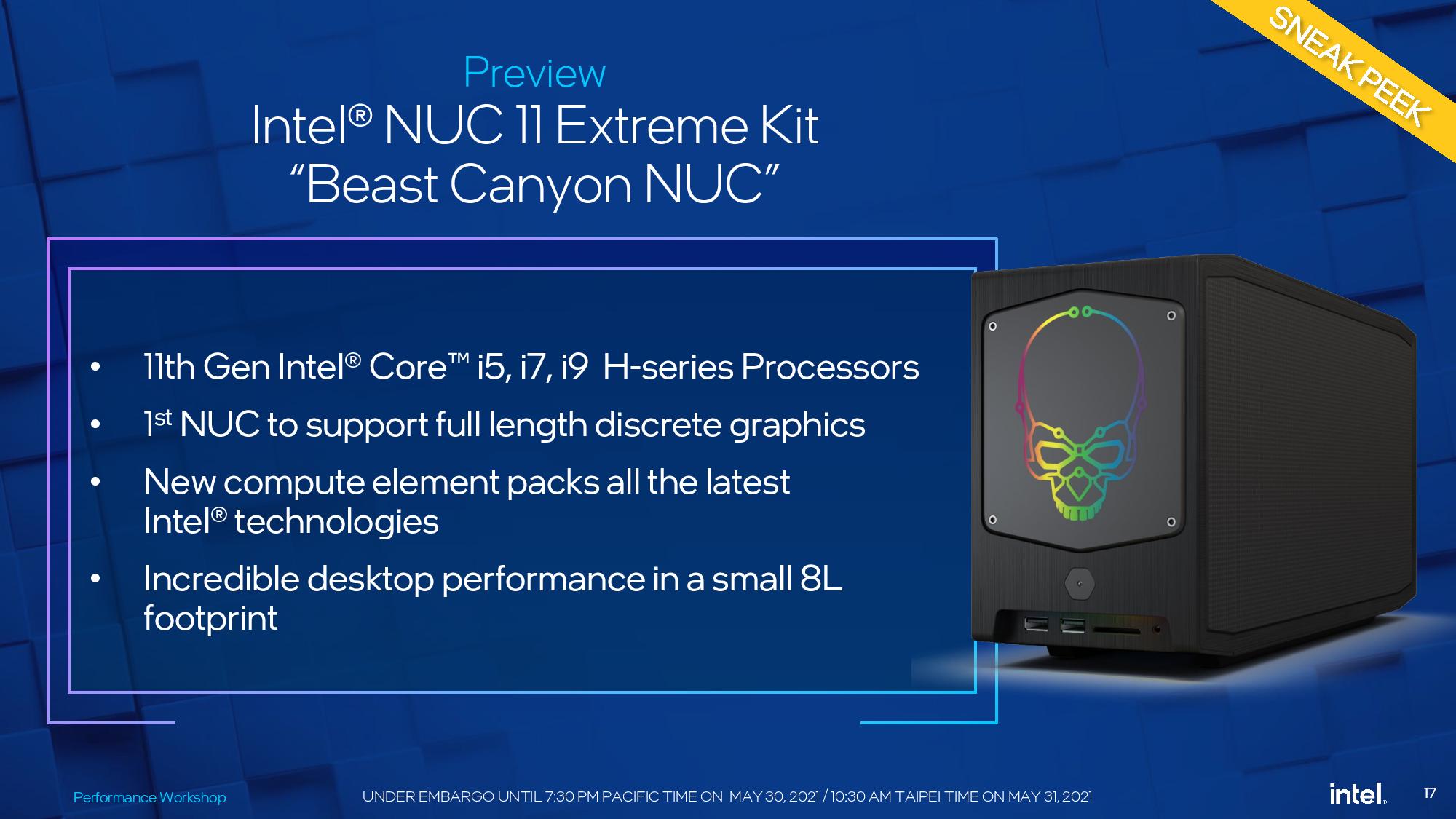
Intel briefly showed off its upcoming Beast Canyon NUC that will sport 65W H-Series Tiger Lake processors and be the first NUC to support full-length graphics cards (up to 12 inches long).
The eight-litre Beast Canyon certainly looks more like a small form factor system than what we would expect from the traditional definition of a NUC, and as you would expect, it comes bearing the Intel skull logo. Intel's Chief Performance Strategist Ryan Shrout divulged that the system will come with an internal power supply. Given the size of the unit, that means there will likely be power restrictions for the GPU. We also know the system uses standard air cooling.
Intel is certainly finding plenty of new uses for its Tiger Lake silicon. The company recently listed new 10nm Tiger Lake chips for desktop PCs, including a 65W Core i9-11900KB and Core i7-11700KB, and told us that these chips would debut in small form factor enthusiast systems. Given that Intel specifically lists the H-series processors for Beast Canyon, it doesn't appear these chips will come in the latest NUC. We'll learn more about Beast Canyon as it works its way to release later this year.
Intel Always Connected PCs Update - Intel 5G Solution 5000
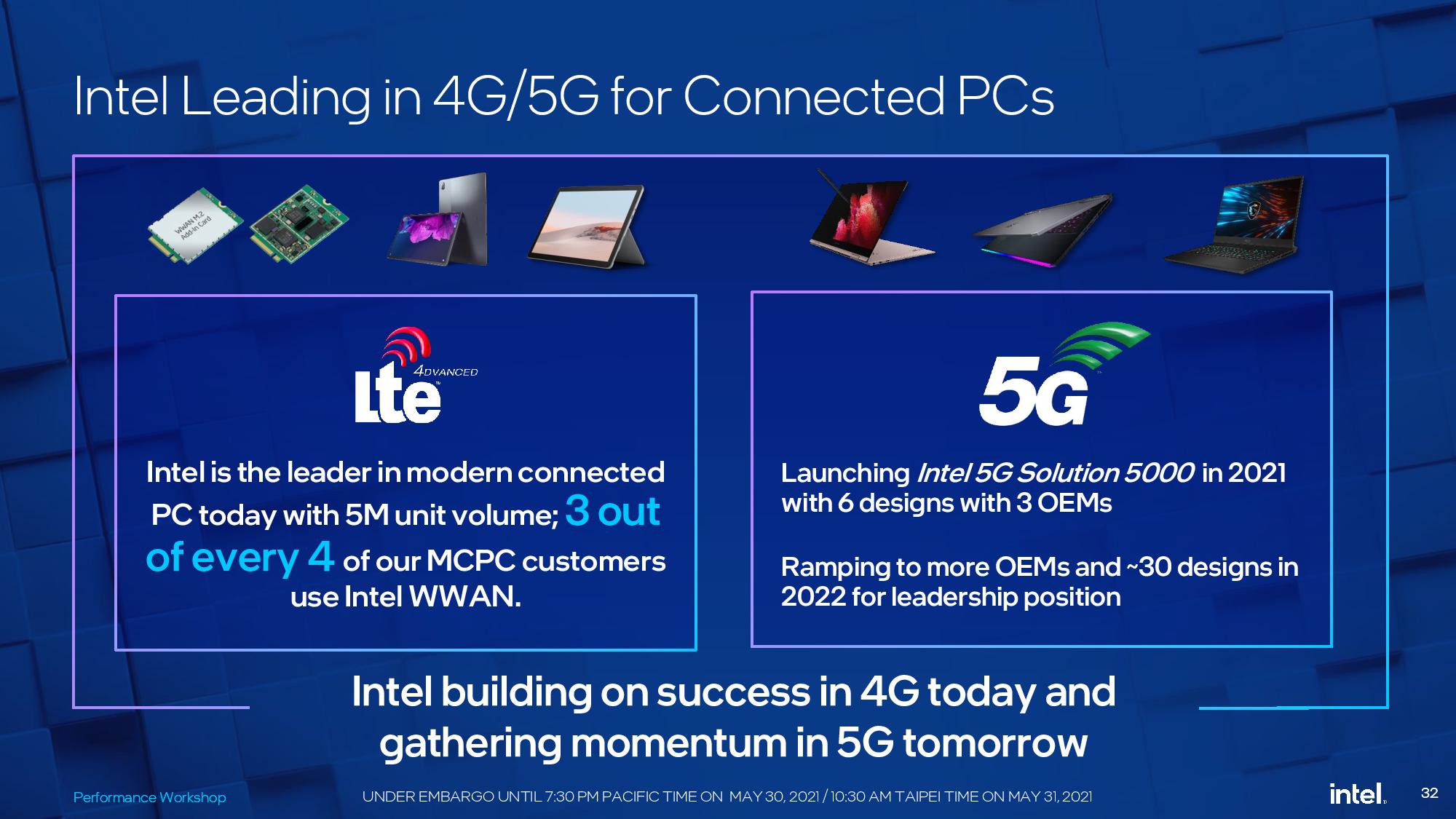
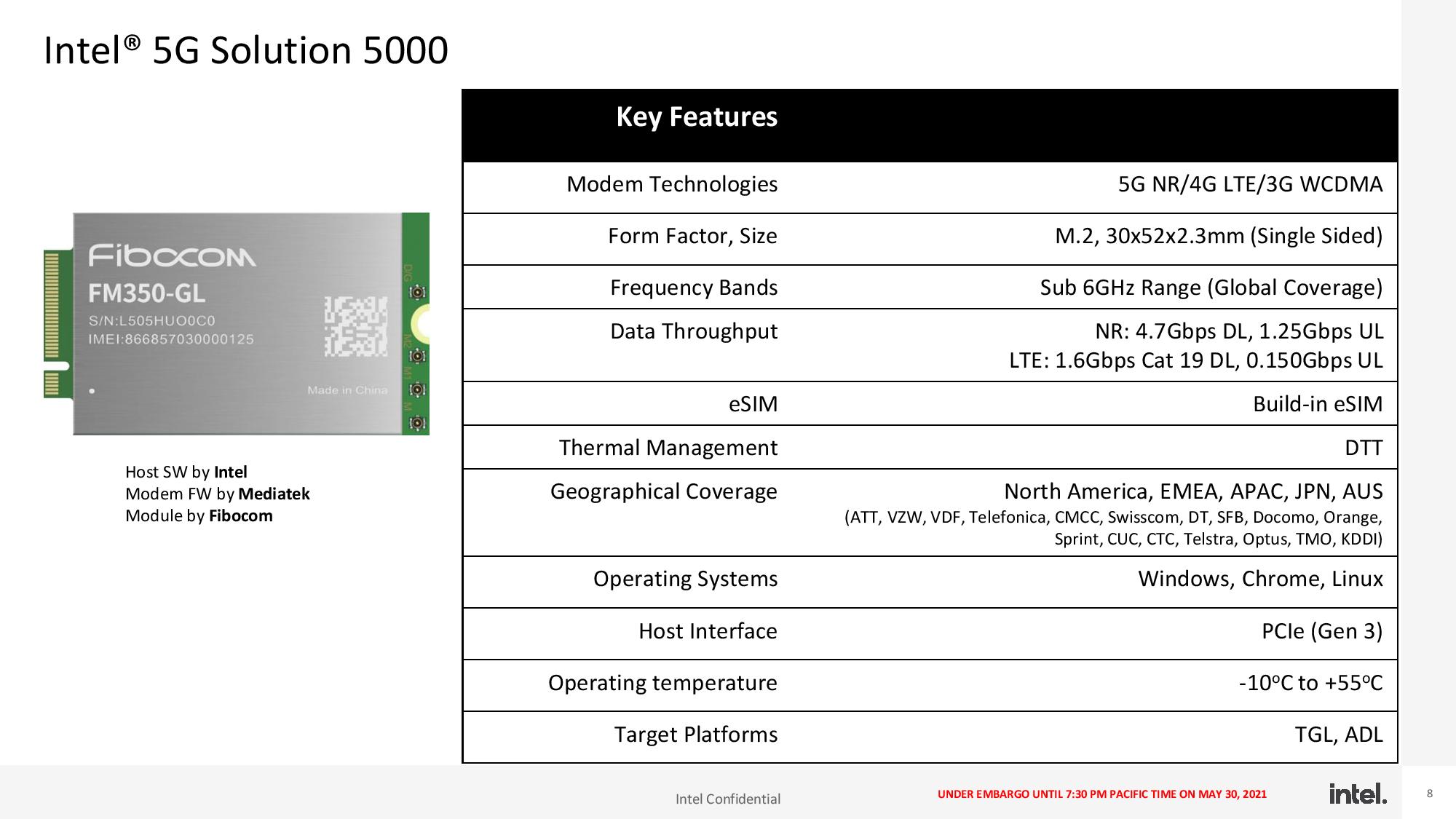
Intel sold its modem business to Apple back in 2019, leaving a gap in its Always Connected PC (ACPC) initiative. In the interim, Intel has worked with MediaTek to design and certify new 5G modems with carriers around the world. The M.2 modules are ultimately produced by Fibocom. The resulting Intel 5G Solution 5000 is a 5G M.2 device that delivers up to five times the speed of the company's Gigabit LTE solutions. The solution is compatible with both Tiger and Alder Lake platforms.
Intel claims that it leads the ACPC space with three out of four ACPCs shipping with LTE (more than five million units thus far). Intel's 5G Solution 5000 is designed to extend that to the 5G arena with six designs from three OEMs (Acer, ASUS and HP) coming to market in 2021. The company says it will ramp to more than 30 designs next year.
Intel says that while it will not be the first to come to market with a 5G PC solution, it will be the first to deliver them in volume, but we'll have to see how that plays out in the face of continued supply disruptions due to the pandemic.

Paul Alcorn is the Editor-in-Chief for Tom's Hardware US. He also writes news and reviews on CPUs, storage, and enterprise hardware.
-
watzupken That is one very ugly NUC with the skull image in front... and it looks huge.Reply
As for the Tiger Lake refresh, the higher boost clock is not unexpected, and I think besides it being the first to boost to 5Ghz for an ultra low power CPU, they can also add the most power hungry title to it. That extra boost clockspeed don't come free for sure. I believe they lowered the base clockspeed to try and offset the increase in opportunistic boost power requirements, and to also allow the CPU to be cool enough so that its got a few seconds to boost as high as possible. -
Findecanor If it is bigger than some mITX cases, is it still a NUC?Reply
I know it is Intel's brand, but still... a word has stand for something or it will lose its meaning.